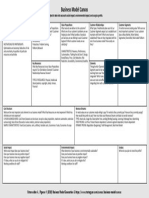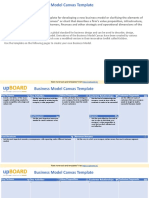0% found this document useful (0 votes)
51 views2 pagesBusiness Model Canvas
The Business Model Canvas is a strategic management tool that consists of nine building blocks: Key Partners, Key Activities, Key Resources, Value Proposition, Customer Relationships, Customer Segments, Channels, Revenue Streams, and Cost Structure. Each block helps businesses design and innovate their models to effectively serve customers and maintain competitiveness. Understanding these components enables businesses to optimize their operations and value delivery.
Uploaded by
Kumbirai KaruwoCopyright
© © All Rights Reserved
We take content rights seriously. If you suspect this is your content, claim it here.
Available Formats
Download as DOCX, PDF, TXT or read online on Scribd
0% found this document useful (0 votes)
51 views2 pagesBusiness Model Canvas
The Business Model Canvas is a strategic management tool that consists of nine building blocks: Key Partners, Key Activities, Key Resources, Value Proposition, Customer Relationships, Customer Segments, Channels, Revenue Streams, and Cost Structure. Each block helps businesses design and innovate their models to effectively serve customers and maintain competitiveness. Understanding these components enables businesses to optimize their operations and value delivery.
Uploaded by
Kumbirai KaruwoCopyright
© © All Rights Reserved
We take content rights seriously. If you suspect this is your content, claim it here.
Available Formats
Download as DOCX, PDF, TXT or read online on Scribd
/ 2




















































































